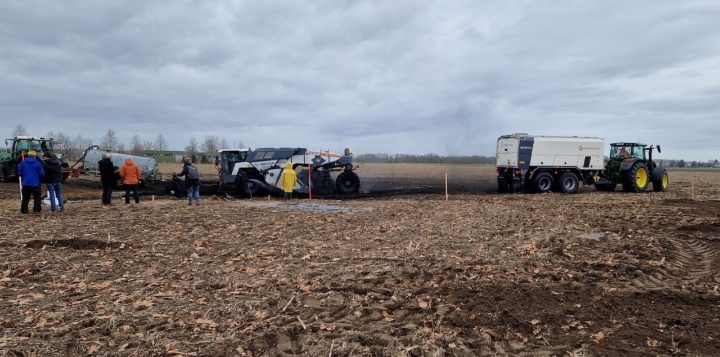PFAS (per-and polyfluoroalkyl substances) are a global environmental and health issue. There is extensive soil contamination near Hügelsheim in the district of Rastatt. In this area, compost mixed with paper sludge containing PFAS was spread on agricultural land in the past. Within the framework of the BMBF PFClean project, researchers from the University of Stuttgart are testing how activated carbon in the soil could bind harmful substances and thus protect the groundwater.
“Contamination by PFAS poses a serious threat to water resources. Until now, it hasn’t been possible to effectively remediate contaminated soil on site,” says Dr. Claus Haslauer, Scientific Director of the Research Facility for Subsurface Remediation (VEGAS) at the University of Stuttgart.
Stopping the transport of harmful substances into the groundwater
In the project “PFClean – An Innovative Modular System for the Sustainable Reduction of PFAS Contaminants from Soil and Groundwater”, a team from the University of Stuttgart headed by Haslauer is currently testing a method in a field trial of reducing the contamination of groundwater by the pollutants. In January, the researchers introduced activated carbon into the soil of a contaminated field in Hügelsheim with the support of project partners. The PFAS substances are intended to adhere to the homogeneously incorporated activated carbon. The aim is a higher absorption capacity in the soil, which will stop the further transport of the harmful substances into the groundwater.
Whether this method will be successful is investigated by the PFClean team with the aid of a detailed monitoring system. This includes taking groundwater samples from 13 monitoring sites on a regular basis as well as pore water analyses. “In this way, we hope to find a viable way of sustainably managing the pollutant load in the groundwater,” says Haslauer.
After trials in the laboratory, PFClean is testing approaches on site
Successful laboratory experiments preceded the pilot project on site in Hügelsheim. The project, which started in March 2023, investigates not only the increase in the absorption capacity of soils, but also further approaches for PFAS remediation technologies such as the removal of PFAS using so-called funnel-and-gate systems. In this method, impermeable walls built into the subsoil control the direction of groundwater flow in order to retain the PFAS at a single point. Other tests are concerned with the degradation of harmful substances by microorganisms and at different temperatures.

“To date, there are hardly any in-situ remediation technologies, meaning the removal on site, at the source of the contamination,” says Haslauer. This is due to the wide range of possible properties of PFAS: Some are mobile and can be easily transported in the subsoil and carried into the groundwater. Others bind strongly to soil materials. All of them are very stable due to carbon-fluorine bonds. For this reason, they are also called “forever chemicals”. Until now, PFAS have been removed from contaminated water using various treatment techniques, for example in waterworks, but not at the source of the contamination, i.e. directly from soil and groundwater.
The goals of PFClean are to test on site and, if necessary, refine the approaches developed in the laboratory and in large-scale trials for the remediation and removal of PFAS from soil and groundwater, and to achieve a rapid and effective transfer from science to real-life application. In addition to the location in Hügelsheim, trials in Reilingen, south of Heidelberg, are planned. There, at individual points, PFAS found their way into the ground from fire-extinguishing foams.
Background: PFAS (per- and polyfluoroalkyl substances)
The substance group of per- and polyfluoroalkyl substances comprises about 5000 individual substances. PFAS are dirt-, water-, and grease-repellent and can be found in countless products: in outdoor jackets, frying pans, paper and cardboard, in shampoo, varnishes, and fire-extinguishing foam. Some of the chemicals are harmful to health. High concentrations in the blood may damage organs or cause cancer. For decades, PFAS have been finding their way into the environment, for example, in wastewater and exhaust gas. They accumulate in soils and groundwater and decompose only very slowly.
About the project
The network project “PFClean – An Innovative Modular System for the Sustainable Reduction of PFAS Contaminants from Soil and Groundwater” runs from March 1, 2023, to February 28, 2026. It is one of the research and development projects on the topic of “Sustainable Groundwater Management” (LURCH) [de] that are funded by the Federal Ministry of Education and Research (BMBF) within the framework of the “Research for Sustainability” (FONA) strategy. Under the leadership of the University of Stuttgart, VEGAS, project partners include:
- Eberhard Karls University of Tübingen, Department of Environmental Analytical Chemistry
- DVGW Water Technology Center, Karlsruhe
- Arcadis Germany GmbH, Darmstadt
- Geiger Entsorgung GmbH und Co KG, Oberstdorf
- Industrie Engineering GmbH, Reutlingen
- Sax + Klee GmbH building contractor, Mannheim
- Rastatt Administrative District Office, PFAS Office
The pilot project in Rastatt is supported by the Wirtgen Group, the Gartner John Deere agricultural machinery company, and STREUMASTER Maschinenbau GmbH.

Lydia Lehmann
Deputy Head of University Communications


